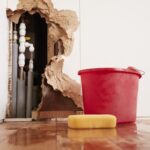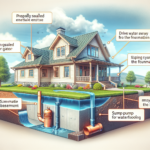Septic tank issues can be a homeowner’s nightmare, often leading to costly repairs and potential health hazards. Many property owners wonder if their homeowners insurance covers septic tank failure, a crucial question given the significant expenses associated with septic system maintenance and replacement. Understanding the extent of coverage can help homeowners prepare for unexpected problems and make informed decisions about their insurance policies.
Homeowners insurance policies vary in their coverage of septic tank-related issues. While some scenarios, such as damage from lightning strikes or vandalism, may be covered, routine maintenance and wear-and-tear are typically excluded. This article explores the circumstances under which septic tank failure might be covered by insurance, common exclusions, and the importance of regular inspections and preventative maintenance. By understanding these factors, homeowners can better protect themselves from the financial burden of septic system problems.
Understanding Septic Tank Coverage in Homeowners Insurance
Septic tanks typically fall under the “other structures” coverage portion of a homeowners insurance policy. This section protects structures on the property that are not attached to the house, such as gazebos, sheds, detached garages, and in many cases, septic tanks. Generally, home insurance policies extend other structures coverage as 10 percent of the dwelling limit. For instance, if a homeowner has $300,000 in dwelling coverage, they would potentially have $30,000 in other structures coverage.
Types of septic system damage covered
Standard homeowners insurance policies usually cover septic tank damage resulting from sudden, unexpected events. Common perils not excluded from standard policies include:
- Fire and smoke damage
- Vandalism and riots
- Hail, windstorms, and lightning
- Explosions
- Falling objects
- Damage from aircraft or vehicles
If any of these perils cause sudden or accidental damage to a septic tank, homeowners insurance will typically cover the damage, minus the chosen deductible. The policy may also cover the cost of removing waste material, repairing damaged carpentry, and cleaning necessary after a septic tank backup.
Common exclusions in septic tank coverage
While homeowners insurance provides coverage for certain types of damage, there are several common exclusions:
- Wear and tear: Damage occurring over time due to regular use is generally not covered.
- Lack of maintenance: Issues arising from neglected upkeep are typically excluded.
- Tree root damage: Problems caused by roots slowly cracking tanks or pipes are often not covered.
- Improper installation: Damage resulting from incorrect installation, such as a septic tank not buried deep enough, is usually excluded.
- Natural disasters: Standard policies do not cover damage from floods, earthquakes, or landslides.
- Sewer line issues: Problems involving the city sewage line leading to the home are not covered under home insurance.
Importance of reviewing your policy
It’s crucial for homeowners to carefully review their insurance policies to understand the extent of their septic tank coverage. Policy limits and specific exclusions can vary between insurers. To further protect against septic system-related costs, homeowners may consider additional coverage options:
- Service line coverage: This endorsement can protect against damage to pipes feeding to the septic tank.
- Water backup coverage: Also known as sump pump coverage, this can help with repair costs if water backs up into the home from sewer or drain lines.
- Flood insurance: While not part of standard policies, flood insurance can provide an extra layer of protection for septic tanks in flood-prone areas.
By understanding these coverage options and limitations, homeowners can better prepare for potential septic system issues and make informed decisions about their insurance needs.
Scenarios When Septic Tank Failure May Be Covered
Sudden and accidental damage
Homeowners insurance policies typically cover septic tank damage resulting from sudden and unexpected events. These situations are considered acute, meaning the homeowner could not have prevented them. Standard policies rarely cover costs associated with repairing or replacing septic system components unless the damage is caused by a covered peril. For instance, if the top of the septic tank gets damaged in a fire, the policy will generally cover the replacement.
Covered perils affecting septic systems
Most standard home insurance policies cover septic tank damage from specific perils up to policy limits. Common covered perils include:
- Fire and lightning strikes
- Explosions
- Vandalism and riots
- Hail and windstorms
- Falling objects
- Damage caused by aircraft or vehicles
In these cases, the insurance company will likely approve the claim. Some insurers may also cover cracks in fiberglass septic tanks, although this coverage may not extend to the pipes leading to the tank.
Filing a claim for septic tank damage
Before filing a claim for septic damage, homeowners should carefully review their policy to determine if they have purchased protection for this type of event. If septic systems are covered, they must file a claim for the protection they’ve paid for. To file a claim, homeowners should follow these steps:
- Document the damage by taking pictures and videos
- Tape off toilets and sinks to prevent usage until the problem is fixed
- Contact the homeowners insurance agent to initiate the claim process
- Meet with an insurance adjuster for an in-person inspection of the damage
It’s important to note that wastewater from a septic system backup can pose significant health risks. Homeowners should keep family members and pets away from affected areas and consider wearing protective gear, such as gloves and masks, when documenting the damage.
While septic tank coverage is typically included in the “other structures” portion of a homeowners insurance policy, it’s crucial to understand the specific limitations and exclusions. Generally, home insurance policies extend other structures coverage as 10 percent of the dwelling limit. For example, a policy with $300,000 in dwelling coverage would potentially provide $30,000 in other structures coverage.
When Septic Tank Failure Is Not Covered by Insurance
Homeowners insurance policies typically do not cover septic system problems related to normal wear and tear or neglected maintenance. Most standard policies are designed to protect against sudden and unforeseen damages, such as those resulting from specific perils like fires or storms. However, there are several scenarios where septic tank failure is not covered by insurance.
Normal wear and tear
Over time, septic systems naturally deteriorate due to regular use. Insurance companies generally exclude coverage for issues arising from the aging process or gradual wear and tear. Homeowners are responsible for the costs associated with repairing or replacing components that have reached the end of their lifespan.
Lack of maintenance
Insurance policies often exclude damage resulting from inadequate maintenance. Proper upkeep of septic systems is crucial to prevent costly breakdowns. Some common maintenance-related issues not covered by insurance include:
- Failure to pump the tank regularly
- Neglecting routine inspections
- Ignoring signs of system malfunction
- Not addressing tree root intrusion
To avoid these problems, homeowners should have their septic tanks inspected and pumped annually, use water efficiently, and avoid flushing harmful substances.
Improper installation or use
Damage caused by improper installation or misuse of the septic system is typically not covered by insurance. Examples include:
- Driving vehicles over the drain field or septic tanks
- Flushing non-biodegradable items down toilets
- Pouring chemicals or oils into the system
- Building structures over the septic system
To protect their septic systems, homeowners should avoid these actions and educate family members about proper usage. Additionally, it’s crucial to hire qualified professionals for any maintenance or alterations to the septic system.
Conclusion
Understanding the coverage and limitations of homeowners insurance regarding septic tank failure has a significant impact on a homeowner’s preparedness for unexpected issues. While sudden and accidental damage from covered perils is often included, normal wear and tear, lack of maintenance, and improper use typically fall outside the scope of standard policies. This knowledge empowers homeowners to make informed decisions about their insurance needs and to implement proper maintenance routines.
To protect themselves from potential financial burdens, homeowners should consider reviewing their policies, exploring additional coverage options, and establishing regular inspection and maintenance schedules for their septic systems. By taking these proactive steps, property owners can minimize the risk of costly repairs and ensure the longevity of their septic systems. In the end, a well-maintained septic system not only saves money but also contributes to a healthier living environment for the entire household.
FAQs
1. Are septic system failures typically covered by homeowners insurance?
Yes, your septic tank, as part of your home, is covered by your homeowners insurance if the damage is sudden and accidental. However, damage resulting from neglect or lack of maintenance is not covered under standard policies.
2. Is the septic drain field covered under homeowners insurance in Georgia?
In Georgia, your septic system, including the drain field, is generally considered part of your property and is covered by homeowners insurance. However, coverage can vary and there are many scenarios where damage might not be covered.
3. Does homeowners insurance provide coverage for water heater failures?
Homeowners insurance will likely cover the water damage caused by a failing water heater if the unit has been properly maintained. This can include costs for repairing or replacing things like flooring and furniture. However, the costs to repair or replace the water heater itself are not covered unless you have added equipment breakdown coverage to your policy.
We represent home and business owners and have vast experience with the following types of claims:
- Fire and smoke damage claims
- Water damage claims
- Flood damage claims
- Theft and vandalism damage claims
- Snow and ice damage claims
- Building collapse claims
- Wind and hail damage claims
- Catastrophic damage claims
- Roof leaks
- Blown off shingles & siding
- All plumbing leaks
- Toilet overflow
- Burst Pipes
- Frozen Pipes





